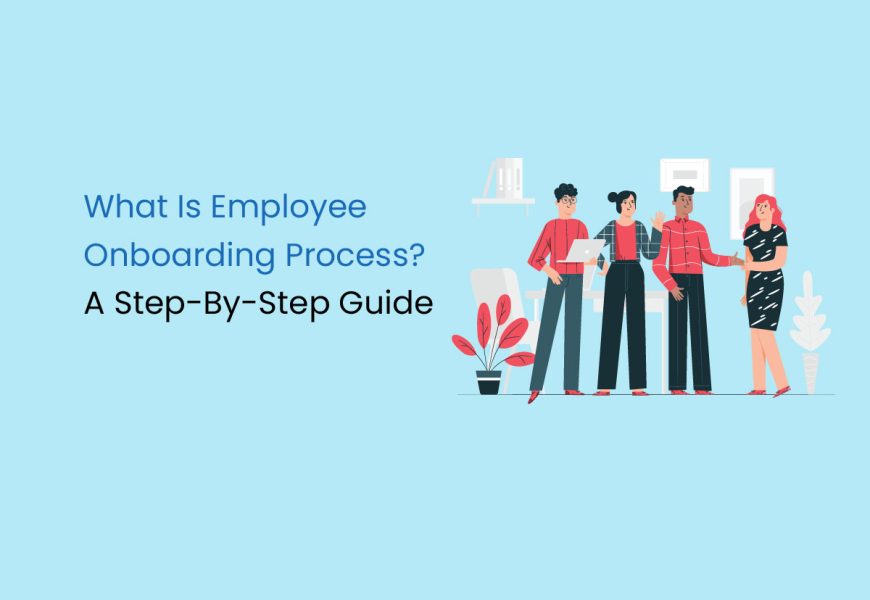Your upcoming new hire is cause for celebration! After all, your team has invested considerable time and effort in finding the perfect candidate, so ensuring their long-term success and satisfaction within your organisation is the most important. And it all begins with a stellar onboarding process.
In our comprehensive guide, we take a closer look into the essence of employee onboarding, breaking down each step of the process to illuminate its significance. We explore why effective onboarding matters deeply to organisations that prioritise their people, offering insights into crafting an experience that fosters engagement and productivity from day one.
What is Onboarding?
Employee onboarding is a crucial process that encompasses introducing a new employee to the organisation’s policies, their role within the company, and the organisational culture. It’s about creating an environment where the employee feels comfortable interacting with colleagues and establishing social connections in the workplace.
During onboarding, the employee completes the necessary paperwork for labour law compliance and is provided with the tools and resources essential for their job. They also learn about the organisation’s expectations regarding skills, communication style, and attitude.
Research indicates that hiring is not only time-consuming but also costly. Moreover, retaining employees hinges on effective onboarding. Without optimal onboarding, there’s a risk of losing valuable hires, leading to additional expenses associated with hiring replacements.
The success of employee onboarding depends on the efficiency of the onboarding program. The sooner employees are empowered to perform their duties effectively, the quicker they become valuable contributors to the organisation.
It’s essential to recognise that onboarding isn’t solely HR’s responsibility. Immediate managers play a crucial role in familiarising employees with their roles, performance expectations, and team culture.
Furthermore, onboarding isn’t limited to new hires. Employees transitioning into new roles, known as crossboarding, also require onboarding. While they may be familiar with organisational culture and policies, they may still need guidance to navigate their new role and team dynamics effectively.
What is the Importance of Onboarding?
Onboarding is crucial for several reasons. Firstly, it significantly impacts employee retention. When new hires don’t receive adequate attention and guidance during their initial days, it can dampen their enthusiasm and motivation, leading to early exits. Studies show that more than 25% of new hires leave their jobs within the first three months, resulting in significant losses for companies in terms of time and resources spent on hiring and training replacements.
Effective onboarding processes contribute to higher employee retention rates by ensuring that new hires feel welcomed, supported, and equipped to succeed in their roles from the start.
Additionally, a well-executed onboarding program accelerates the time it takes for new employees to reach full productivity. New hires may struggle to navigate their responsibilities and the company’s culture without proper guidance, delaying their ability to contribute meaningfully. This delay can result in missed revenue opportunities for the company.
Conversely, a robust onboarding process helps new hires quickly acclimate to their roles, understand expectations, and integrate into their teams. This accelerated integration allows them to start adding value to the organisation sooner, ultimately enhancing productivity and driving business outcomes.
Furthermore, effective onboarding is essential for remote employees, who face additional challenges in building connections and rapport with colleagues due to geographical distance. Similarly, interns and graduates, who are new not only to the company but also to the professional world, benefit greatly from structured onboarding programs tailored to their needs.
Why Should You Be Welcoming New Hires?
Welcoming new hires goes beyond just completing paperwork and training sessions. It’s about creating a positive and inclusive environment where employees feel valued, supported, and excited to contribute to the company’s success.
Effective onboarding strategies consist of two essential components: providing new hires with the necessary information and tools to excel in their roles and fostering a welcoming and supportive atmosphere within the organisation.
Organisations set new hires up for success by ensuring that they are equipped with all the information they need about company policies, benefits, job responsibilities, and technology tools. This preparation enables employees to hit the ground running and perform their duties efficiently, minimising confusion and frustration.
However, beyond practicalities, a successful onboarding experience also focuses on creating a sense of belonging and connection for new hires. By cultivating a positive work culture that values diversity, collaboration, and open communication, organisations demonstrate their commitment to employee well-being and engagement.
A well-structured onboarding process not only helps new hires integrate seamlessly into the team but also contributes to long-term employee satisfaction and retention. When employees feel welcomed and supported from day one, they are more likely to become invested in their roles and motivated to contribute their best efforts to achieve shared goals.
Onboarding Process
Providing comprehensive information about company policies, benefits, and job roles is crucial for ensuring new employees feel prepared and supported as they join the organisation. Here’s a breakdown of the key steps involved in this process:
Company Policies and Compliance Forms
On the first day, new hires should receive detailed information about company policies, including compliance requirements, insurance details, tax liabilities, and diversity and inclusion initiatives. They should also be provided with all necessary compliance forms to sign, formalising their status as members of the organisation. Utilising digital signatures through employee onboarding software can streamline this process, allowing employees to complete compliance formalities before their first day, especially beneficial for remote hires.
Role Clarity
New employees need clarity about their job roles and responsibilities to contribute to the organisation effectively. The immediate manager should communicate this information, who can provide insights into daily tasks, collaboration expectations, and reporting structures. Ideally, this role clarity should be provided over the first 30 days on the job, allowing new hires to take ownership of their roles gradually. Using automated solutions like Bamboo HR or Boardon can facilitate introductions to team members and provide access to training materials even before the first day.
Training Facilitation
Training is a critical aspect of the onboarding process and is best facilitated by the immediate manager. Basic training materials can be shared beforehand, and employees can be briefed on tasks they’re expected to accomplish through onboarding software. Solutions like Hibob and Freshteam offer customisable workflows and efficient pre-onboarding processes to streamline training initiatives.
Assimilation into Organizational Culture
Assimilating new employees into the organisational culture is an ongoing process that starts from day one. HR managers and team leaders should provide a broad overview of the company’s culture, values, and mission statement. This can be reinforced through onboarding software, which provides insights into team dynamics and company culture, offering new hires a glimpse into the organisation’s ethos.
Social Connections with Colleagues
While forming social connections is not solely the responsibility of HR or managers, they should facilitate communication and encourage camaraderie among employees. Assigning new-hire buddies or utilising chatbots as virtual assistants can help new hires navigate the workplace and build relationships with colleagues. However, it’s essential to create an environment where all employees feel encouraged to forge friendships and collaborate effectively.
How Much Time Does Onboarding Take?
The duration of employee onboarding can vary depending on the organisation’s specific processes and goals. Here’s a breakdown of the typical duration and phases of onboarding:
Day 1 to Week 1
During the first week, the focus is on compliance and familiarisation with the role. New hires typically spend between two to five hours completing compliance documents and getting introduced to the team. It’s beneficial to encourage new hires to join internal platforms ahead of their first week to familiarise themselves with company policies, and employee handbook, and connect with colleagues.
Week 1 to Month 3
In the following weeks, the emphasis shifts to the training period to equip employees with necessary job skills. This period also involves introducing employees to key colleagues who play a role in their function and helping them understand the company culture and values.
Month 3 to Month 6
Between the third and sixth months, the focus is on evaluating employee performance and providing ongoing support. It’s essential to ensure employees have the resources and support needed to perform their job effectively during this phase. Gathering feedback from employees helps assess their engagement and satisfaction.
Month 6 to Year 1
From the sixth month to the end of the first year, employees should have developed a comprehensive understanding of their role, the market, the company, and the industry. They should also have assimilated into the company culture and established strong relationships with colleagues. Continued opportunities for growth and development are crucial during this phase.
Need For An Onboarding Checklist
An onboarding checklist serves as a crucial tool in ensuring a smooth and effective transition for new hires. Here’s why it’s important:
- Organisation and Structure: Starting a new job can be overwhelming for employees, with many tasks and details to manage. An onboarding checklist provides a structured and organised approach, guiding both the new hire and the onboarding team through the process.
- Clarity and Confidence: A checklist helps new hires understand what to expect during their onboarding journey, alleviating feelings of anxiety and uncertainty. It provides clarity on the steps involved in the onboarding process, empowering employees to navigate their new roles and environment with confidence.
- Prioritisation of Tasks: With numerous tasks to complete, it’s essential to prioritise the most important aspects of onboarding. A checklist ensures that critical tasks, such as completing compliance documents or attending orientation sessions, are given appropriate attention and addressed on time.
- Consistency and Compliance: An onboarding checklist promotes consistency in the onboarding process across different departments and teams within the organisation. It helps ensure that all necessary tasks, including compliance requirements and policy acknowledgements, are completed uniformly for every new hire.
- First Impression: Onboarding is the first opportunity for an organisation to make a positive impression on new employees. A well-structured checklist demonstrates to new hires that the company is organised, efficient, and invested in their success, fostering a sense of belonging and engagement from day one.
Remote Onboarding
Remote onboarding presents unique challenges for HR professionals, requiring innovative approaches to ensure new hires feel welcomed and supported, even from a distance. Here’s how to effectively onboard remote employees:
- Streamline Formal Workflow: Remote onboarding requires a well-structured and efficient workflow to guide new hires through the process. Communicate all necessary steps, documents, and deadlines involved in the onboarding process to remote workers to minimise confusion and ensure compliance.
- Utilise Communication Tools: Help remote employees become familiar with the company’s communication tools and platforms as quickly as possible. Provide comprehensive training and support to ensure they can effectively navigate virtual communication channels, such as email, instant messaging apps, and video conferencing tools.
- Facilitate Virtual Meetings: Arrange video calls or virtual meetings with relevant managers, team members, and key stakeholders to introduce remote employees to their colleagues and establish personal connections. These interactions provide opportunities for new hires to ask questions, clarify expectations, and build relationships despite physical distance.
- Assign Onboarding Buddy: Pair remote employees with an “onboarding buddy” or mentor who can offer guidance, support, and assistance throughout the onboarding process. This designated colleague can serve as a point of contact for questions, provide insights into company culture, and help new hires navigate remote work dynamics.
- Utilise Onboarding Software: Leverage onboarding software to streamline and automate various aspects of the remote onboarding process. These tools facilitate the organisation of onboarding tasks, enable digital document management, and provide personalised onboarding experiences for remote employees.
FAQs About Onboarding
What are the steps in the onboarding process?
The onboarding process entails regular communication with new hires, planning their initial week, extending a warm welcome, and providing ongoing support. It's imperative to have a well-structured plan that encompasses these steps to ensure the successful integration and engagement of employees.
Why is an onboarding checklist important?
An onboarding checklist serves as a structured guide that prioritises essential aspects of welcoming a new hire. It assists new employees in gaining confidence about their role and environment, thereby facilitating a strong initial impression. Moreover, it ensures that no crucial steps are overlooked during the onboarding process.
What is remote onboarding?
Remote onboarding refers to the process of welcoming and integrating new hires who work remotely. It involves clear communication, familiarisation with company communication tools, arranging virtual meetings, and potentially assigning an "onboarding buddy" to provide support to the new hire.
What are the 7 stages of onboarding?
The onboarding process typically comprises seven stages:
- Talent Acquisition: Identifying and attracting suitable candidates for the job.
- Recruitment: The formal process of selecting and hiring candidates.
- Engaged Pre & Onboarding Experiences: Providing informative and engaging experiences before and during the onboarding process.
- Employee Engagement: Fostering a sense of involvement and commitment among new hires.
- Development and Training: Offering opportunities for skill development and training to enhance employee capabilities.
- Talent Retention: Implementing strategies to retain valuable talent within the organisation.
- Offboarding: Facilitating a smooth transition for employees leaving the organisation.
What is the Employee Lifecycle?
The Employee Lifecycle encompasses seven stages:
- Find Talent: Identifying potential candidates who match the job requirements.
- Recruit Talent: The process of attracting, selecting, and hiring candidates.
- Provide Engaged Pre & Onboarding Experiences: Offering informative and engaging experiences before and during the onboarding process.
- Boost Employee Engagement: Cultivating a sense of commitment and involvement among employees.
- Encourage Development and Provide Training: Supporting employees in their professional growth through development opportunities and training programs.
- Reduce Talent Retention: Implementing strategies to minimise turnover and retain valuable talent.
- Prepare for Offboarding: Facilitating a smooth transition for employees leaving the organisation.
What are the 5 C's of onboarding?
The 5 C's of Employee Onboarding are:
- Compliance: Ensuring new hires understand and adhere to company policies and regulations.
- Clarification: Providing clarity on job responsibilities, expectations, and performance objectives.
- Confidence: Instilling confidence in new hires by providing the necessary support and resources for success.
- Connection: Facilitating connections with colleagues, managers, and the organisational culture.
- Culture: Introducing new hires to the company's values, norms, and work environment to foster cultural integration and alignment.





















